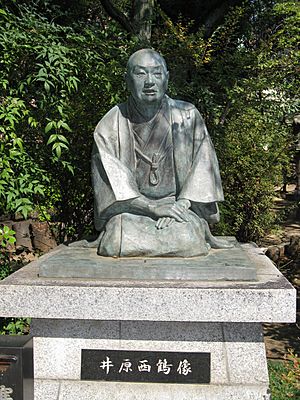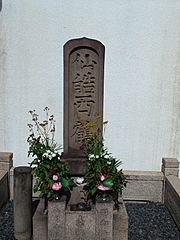Ihara Saikaku facts for kids
Quick facts for kids
Ihara Saikaku
井原 西鶴 |
|
|---|---|

Portrait of Ihara Saikaku
|
|
| Born | 1642 Osaka, Japan |
| Died | 1693 Osaka |
| Occupation | Writer |
| Genre | Poetry, Fiction |
| Literary movement | Ukiyo-zōshi |
Ihara Saikaku (井原 西鶴, 1642 – September 9, 1693) was a famous Japanese poet and writer. He created a special type of Japanese story called "floating world" prose (ukiyo-zōshi). He was born in Osaka, Japan, to a rich merchant family. Saikaku first learned about haikai poetry. Later, he became known for writing about the lives of merchants and city people.
Contents
About Ihara Saikaku

Ihara Saikaku was born in 1642 in Osaka, Japan. His family was well-off merchants. When he was fifteen, he started writing haikai no renga, which is a type of linked verse poetry. By the time he was twenty, in 1662, he became a master of haikai.
He used the pen name Ihara Kakuei at first. He became a popular haikai poet. By 1670, he had his own unique writing style. He used everyday language to describe the lives of ordinary city people, called chōnin. During this time, he also ran a business in Osaka.
In 1673, he changed his pen name to Saikaku. A sad event happened in 1675: his beloved wife passed away. A few days after her death, Saikaku wrote a thousand-verse haikai poem in just twelve hours. This poem was published as Haikai Single Day Thousand Verse. It was the longest piece of writing he had tried so far. This big success made him interested in writing novels.
After his wife's death, Saikaku became a lay monk and traveled all over Japan. He left his three children, one of whom was blind, with his family. His business was left to his employees. He started his travels after his blind daughter also passed away.
In 1677, Saikaku returned to Osaka. He learned how popular his thousand-verse poem had become. From then on, he decided to become a full-time writer. He kept writing haikai poetry for a while. But by 1682, he published The Life of an Amorous Man. This was his first work of prose fiction, like a novel.
Saikaku's popularity grew across Japan. He published more and more books. When he died in 1693 at age fifty-one, he was one of the most famous writers of the Tokugawa period. His work was not seen as "high" literature back then. This was because it was popular with the chōnin, or common city people. Today, Saikaku's work is celebrated. It is important for how Japanese fiction developed.
His Famous Books
Ihara Saikaku wrote many different kinds of stories. Here are some of his most well-known works:
Stories About Townspeople
These books tell tales about the daily lives, money, and relationships of ordinary people in the city.
- Twenty Cases of Unfilial Children (本朝二十不孝, Honchō Nijū Fukō, 1686)
- The Eternal Storehouse of Japan (日本永代蔵, Nippon Eitaigura, 1688)
- Reckonings that Carry Men Through the World or This Scheming World (世間胸算用, Seken Munesan'yō, 1692)
Stories About Warriors
These books focus on the lives and honor of samurai and warriors.
- Transmission of the Martial Arts (武道伝来記, Budō Denraiki, 1687)
- Tales of Samurai Honor (武家義理物語, Buke Giri Monogatari, 1688)
See also
 In Spanish: Ihara Saikaku para niños
In Spanish: Ihara Saikaku para niños


